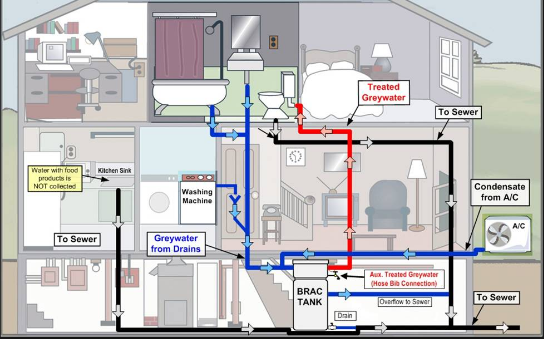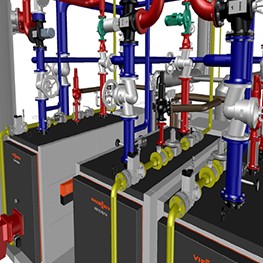A Detailed Look at Your Home's Plumbing System Anatomy
A Detailed Look at Your Home's Plumbing System Anatomy
Blog Article
We've come across this post about Anatomy of a House: Understanding the Components directly below on the internet and decided it made perfect sense to talk about it with you in this article.

Understanding exactly how your home's plumbing system functions is crucial for every single property owner. From delivering clean water for alcohol consumption, cooking, and bathing to securely eliminating wastewater, a well-maintained plumbing system is crucial for your household's health and wellness and convenience. In this extensive guide, we'll discover the complex network that makes up your home's plumbing and offer tips on upkeep, upgrades, and handling usual problems.
Introduction
Your home's plumbing system is more than just a network of pipelines; it's an intricate system that guarantees you have accessibility to clean water and reliable wastewater removal. Knowing its components and just how they collaborate can assist you stop pricey fixings and ensure everything runs smoothly.
Standard Elements of a Pipes System
Pipelines and Tubes
At the heart of your plumbing system are the pipes and tubing that carry water throughout your home. These can be made from different materials such as copper, PVC, or PEX, each with its advantages in regards to toughness and cost-effectiveness.
Components: Sinks, Toilets, Showers, and so on.
Components like sinks, bathrooms, showers, and tubs are where water is used in your house. Recognizing just how these components link to the pipes system assists in identifying issues and preparing upgrades.
Valves and Shut-off Points
Valves manage the circulation of water in your pipes system. Shut-off valves are crucial during emergency situations or when you require to make repair services, enabling you to isolate parts of the system without disrupting water circulation to the whole home.
Supply Of Water System
Main Water Line
The main water line attaches your home to the metropolitan water supply or a personal well. It's where water enters your home and is distributed to various fixtures.
Water Meter and Stress Regulatory Authority
The water meter steps your water usage, while a stress regulatory authority guarantees that water flows at a safe stress throughout your home's plumbing system, preventing damages to pipes and components.
Cold Water vs. Hot Water Lines
Understanding the difference in between cold water lines, which supply water straight from the primary, and hot water lines, which lug warmed water from the water heater, helps in repairing and planning for upgrades.
Drain System
Drain Pipes Water Lines and Traps
Drain pipes lug wastewater away from sinks, showers, and toilets to the sewage system or sewage-disposal tank. Catches avoid sewage system gases from entering your home and likewise trap particles that could trigger blockages.
Ventilation Pipelines
Ventilation pipelines allow air right into the drain system, preventing suction that might slow water drainage and cause catches to empty. Correct air flow is crucial for preserving the integrity of your pipes system.
Importance of Appropriate Drainage
Making sure proper drain prevents backups and water damages. On a regular basis cleaning drains and maintaining traps can protect against expensive fixings and extend the life of your pipes system.
Water Heating System
Kinds Of Hot Water Heater
Water heaters can be tankless or standard tank-style. Tankless heaters warm water as needed, while tanks save heated water for immediate use.
Just How Water Heaters Connect to the Plumbing System
Recognizing just how water heaters link to both the cold water supply and warm water distribution lines assists in detecting concerns like insufficient warm water or leaks.
Upkeep Tips for Water Heaters
Consistently purging your water heater to remove debris, examining the temperature level settings, and examining for leakages can extend its life expectancy and improve energy efficiency.
Usual Plumbing Problems
Leaks and Their Causes
Leaks can occur due to aging pipelines, loosened installations, or high water pressure. Addressing leakages without delay protects against water damages and mold growth.
Obstructions and Clogs
Blockages in drains and toilets are frequently caused by flushing non-flushable things or a build-up of grease and hair. Using drain displays and being mindful of what drops your drains can prevent obstructions.
Indicators of Plumbing Problems to Expect
Low tide pressure, slow-moving drains pipes, foul odors, or uncommonly high water bills are indicators of prospective plumbing issues that need to be attended to quickly.
Pipes Upkeep Tips
Regular Inspections and Checks
Set up annual pipes assessments to catch concerns early. Try to find signs of leakages, corrosion, or mineral accumulation in faucets and showerheads.
Do It Yourself Maintenance Tasks
Simple jobs like cleaning tap aerators, checking for commode leaks using color tablets, or protecting exposed pipelines in cool environments can stop major pipes issues.
When to Call an Expert Plumbing
Know when a pipes issue calls for professional competence. Attempting complicated repairs without proper understanding can result in more damage and higher repair service prices.
Updating Your Plumbing System
Reasons for Upgrading
Upgrading to water-efficient components or changing old pipelines can improve water high quality, minimize water bills, and enhance the worth of your home.
Modern Pipes Technologies and Their Benefits
Explore technologies like wise leak detectors, water-saving bathrooms, and energy-efficient hot water heater that can conserve cash and lower ecological influence.
Cost Considerations and ROI
Compute the ahead of time expenses versus long-lasting cost savings when thinking about pipes upgrades. Lots of upgrades spend for themselves with minimized energy expenses and less repair services.
Environmental Effect and Conservation
Water-Saving Components and Devices
Mounting low-flow taps, showerheads, and bathrooms can substantially minimize water use without compromising performance.
Tips for Decreasing Water Usage
Simple habits like dealing with leakages immediately, taking shorter showers, and running full loads of laundry and recipes can preserve water and reduced your utility costs.
Eco-Friendly Pipes Options
Consider lasting plumbing products like bamboo for flooring, which is durable and eco-friendly, or recycled glass for countertops.
Emergency situation Readiness
Actions to Take During a Pipes Emergency
Know where your shut-off shutoffs are located and just how to turn off the water in case of a burst pipeline or major leakage.
Importance of Having Emergency Situation Contacts Convenient
Maintain call information for neighborhood plumbings or emergency situation services easily available for fast action during a pipes dilemma.
DIY Emergency Situation Fixes (When Applicable).
Short-lived repairs like utilizing duct tape to spot a leaking pipeline or putting a bucket under a leaking tap can minimize damage till a professional plumbing technician shows up.
Final thought.
Recognizing the anatomy of your home's plumbing system empowers you to preserve it properly, saving time and money on repair services. By adhering to regular maintenance routines and remaining educated concerning modern pipes modern technologies, you can guarantee your plumbing system operates effectively for several years to come.
Understanding Your Home Plumbing System: A Comprehensive Guide
Plumbing System: The Lifeline of Your Home
At its core, the plumbing system is designed to perform two primary functions: bring fresh water into your home and remove wastewater. The system is a network of pipes, fixtures, and other components that transport water and sewage. Residential plumbing systems include potable water supply lines, drain-waste-vent (DWV) systems, and various plumbing fixtures that make water use in daily tasks possible.
Key Components:
Water Supply: This part of your plumbing system brings municipal water into your home, passing through the main water supply line. It s responsible for supplying all water needs, from drinking to bathing.
Drainage System: It carries waste and water away from your home to the sewer or septic system. This system includes all the piping within your home that leads to external sewage or septic systems.
Vent System: An essential yet often overlooked component, the vent system allows sewer gases to escape and lets air into the drainpipes, ensuring water and waste move correctly through the system.
Fixture: More Than Just Taps and Toilets
Plumbing fixtures are the most interactive parts of the plumbing system, including faucets, showers, toilets, and sinks. Each fixture is connected to the plumbing system and plays a role in either the delivery of freshwater or the disposal of waste and wastewater.
Types of Fixtures:
Faucets and Sinks: Used for washing hands, dishes, and other daily water needs.
Toilets: Dispose of human waste through the sewage system.
Bathtubs and Showers: Provide bathing facilities, requiring both hot and cold water supply.
Water Supply: The Source of Life
The water supply system is a critical component, ensuring that potable water is available throughout your home for various uses, including drinking, cooking, and cleaning. This system consists of pipes that distribute water to different parts of the house, controlled by valves to regulate the water flow.
Types of Plumbing: Materials and Methods
Various types of plumbing systems and materials are used in residential settings, each with its advantages and applications. From copper and PVC pipes for water supply to cast iron and ABS for drainage, the choice of materials can impact the longevity and efficiency of your plumbing system.
https://intownplumbingtx.com/articles/home-plumbing-system-guide/

Understanding Your Home Plumbing System: A Comprehensive Guide
Plumbing System: The Lifeline of Your Home
At its core, the plumbing system is designed to perform two primary functions: bring fresh water into your home and remove wastewater. The system is a network of pipes, fixtures, and other components that transport water and sewage. Residential plumbing systems include potable water supply lines, drain-waste-vent (DWV) systems, and various plumbing fixtures that make water use in daily tasks possible.
Key Components:
Water Supply: This part of your plumbing system brings municipal water into your home, passing through the main water supply line. It s responsible for supplying all water needs, from drinking to bathing.
Drainage System: It carries waste and water away from your home to the sewer or septic system. This system includes all the piping within your home that leads to external sewage or septic systems.
Vent System: An essential yet often overlooked component, the vent system allows sewer gases to escape and lets air into the drainpipes, ensuring water and waste move correctly through the system.
Fixture: More Than Just Taps and Toilets
Plumbing fixtures are the most interactive parts of the plumbing system, including faucets, showers, toilets, and sinks. Each fixture is connected to the plumbing system and plays a role in either the delivery of freshwater or the disposal of waste and wastewater.
Types of Fixtures:
Water Supply: The Source of Life
The water supply system is a critical component, ensuring that potable water is available throughout your home for various uses, including drinking, cooking, and cleaning. This system consists of pipes that distribute water to different parts of the house, controlled by valves to regulate the water flow.
Types of Plumbing: Materials and Methods
Various types of plumbing systems and materials are used in residential settings, each with its advantages and applications. From copper and PVC pipes for water supply to cast iron and ABS for drainage, the choice of materials can impact the longevity and efficiency of your plumbing system.
https://intownplumbingtx.com/articles/home-plumbing-system-guide/
I was made aware of that report on Understanding Your Home's Plumbing Anatomy through a good friend on a different blog. Those who enjoyed our blog post plz do not forget to share it. We treasure reading our article about Plumbing Installation 101: All You Need to Know.
Book-Now Report this page